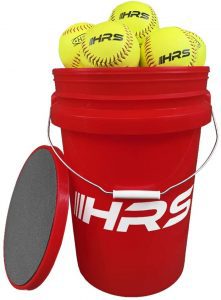The Best Softballs

Our Review Process
Don't Waste Your Money is focused on helping you make the best purchasing decision. Our team of experts spends hundreds of hours analyzing, testing, and researching products so you don't have to. Learn more.
Our Picks For The Top Softballs
- 1. Rawlings 12-Inch Leather Raised-Seam Softballs, 12-Count
- 2. Franklin Sports 12-Inch Flat-Seamed Low-Compression Softball
- 3. MacGregor 12-Inch Fast-Pitch Leather NFHS Softball
- 4. Franklin Sports 12-Inch Compressed-Core Pitcher’s Softball, 12-Pack
- 5. SKLZ Pop-Back Impact Practice Softball, 8-Pack
- 6. Rawlings 14-Inch Raised-Seam Trainer Softball For Pitchers
- 7. Hit Run Steal Official-Size Softballs In 6-Gallon Bucket
These softballs are easy to grip because of raised seams. They are highly durable and ideal for ASA and high school level fastpitch games. The balls have a high-density cork core.
Easy to GripThese softballs have raised seams for better grip and movement.
Throw the maximum distance with these softballs that have flat seams. The balls are an optic yellow color so they are easy to track. They are ideal for beginners, kids and youth softball players.
Maximum DistanceThese softballs have flat seams to minimize air friction.
These softballs are NFHS approved. They have a compression rating of 375 pounds. The COR rating is 0.47.
High QualityThese softballs are approved by the National Federation of State High School Associations.
You can easily see these softballs in daytime or under lights due to the optic yellow color. They have durable construction so you can use them every season. The balls have a COR rating of 0.42 to 0.47.
Optic ColoringThese softballs are easy to track and locate.
Buying Guide
A descendant of baseball, softball is a similar bat-and-ball sport that is played between two teams. Each team has 10 players, and the game is played on a large field with four bases that is a little smaller than a baseball diamond. The goal of the game is to score more runs than the other team by hitting the ball into play and then running the bases.
While the rules of softball are similar to baseball, one of the key differences between the two games is in the ball itself. Softballs are actually a larger size than baseballs. Another difference is that in baseball, the pitcher throws overhand. However, in softball, the pitcher throws underhand.
The name softball suggests that the ball will be soft. However, that’s not the case. In fact, a standard softball is even harder than a baseball. Most softballs are the same bright yellow color and all look the same; however, there are some differences in quality that are important to note if you’re looking to buy a new softball.
Be sure to look at the size of the softball, which uses the circumference measurement. The smallest-size softballs are around 11 inches, and these are usually used for kids’ games because they are the right size for their hands. Some slow-pitch softball games that are co-ed may also use an 11-inch softball. A 12-inch softball is the most common size you will find. It can be used for both fast-pitch and slow-pitch games for youth and adults. There are also 14-inch softballs, which are used in slow-pitch games. These large balls don’t travel fast or far, so they are better for recreational as opposed to competitive games. The largest size of softball is 16 inches, which is often used for senior or wheelchair games. It is a safer option as the ball travels slowly.
What to Look For
- The cover of a softball is made from either a natural or synthetic leather. Natural leather typically lasts longer than synthetic and offers a better grip in wet conditions. However, synthetic leather softballs are more affordable than natural leather.
- Take a look at the seams on a softball. Some are slightly raised which provides a better grip on the ball. Some lie flat on the leather for a smoother feel. The stitching can either be blue or red. If you play in a league, they may specify what kind of stitching your softball needs to have.
- The core of a softball Is made from a number of different materials, including polyurethane, cork and rubber. The type of core you have will affect the compression rating and the COR rating of the softball. A ball with a high compression rating is one that has a hard core and will travel far. If you’re playing in a league, they will specify the compression rating required for the softballs, such as 275, 350, 400 or 525 pounds.
- COR, also known as the coefficient of restitution, refers to how much the softball will bounce against a surface (such as a bat or the ground). A softball that has a high COR rating will bounce farther than one with a low COR rating. Common COR ratings include .40, .44 and .52. Many softball leagues specify the COR rating for your softballs.
More to Explore
While softball and baseball have many similarities, the first softball game actually came about because of a football game. On Thanksgiving Day, 1887, many people were eagerly awaiting the result of a Yale versus Harvard football game at the Farragut Boat Club. Eventually, Yale was announced the winner. One of the Yale alumni threw a boxing glove at a Harvard fan, who swung at the glove with a stick. There began the first softball game, with the players using a rolled-up boxing glove as the ball and a broom handle as the bat. The game was called many names before softball, such as indoor baseball, kitten baseball, mush ball and pumpkin ball. The term softball wasn’t coined until 1926. The set of rules for softball were standardized in 1934.

















